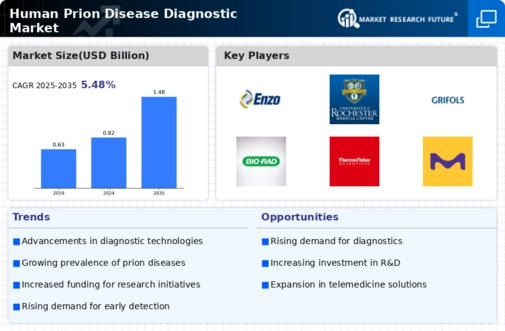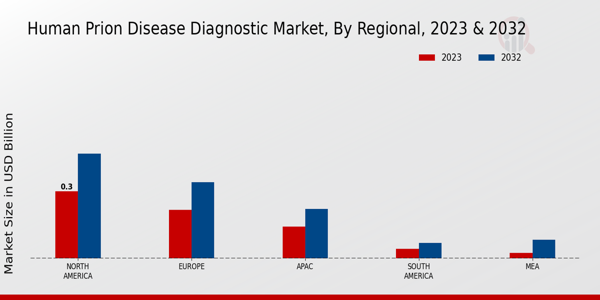Market Growth Projections
The Global Human Prion Disease Diagnostic Market Industry is poised for substantial growth, with projections indicating a market value of 1.48 USD Billion by 2035. This growth trajectory is underpinned by various factors, including increasing prevalence of prion diseases, technological advancements, and heightened awareness among healthcare professionals. The anticipated CAGR of 5.49% from 2025 to 2035 suggests a robust expansion phase, driven by ongoing research and development efforts. As the market evolves, stakeholders are likely to witness significant opportunities for innovation and collaboration, further enhancing the diagnostic landscape for prion diseases.
Growing Awareness and Education
The growing awareness and education surrounding prion diseases are crucial drivers of the Global Human Prion Disease Diagnostic Market Industry. As healthcare professionals and the general public become more informed about the symptoms and implications of prion diseases, the demand for effective diagnostic solutions increases. Educational campaigns and training programs are being implemented to ensure that clinicians can recognize early signs of these diseases. This heightened awareness is likely to lead to earlier diagnoses, thereby improving patient outcomes. Consequently, the market is expected to expand, with a projected value of 1.48 USD Billion by 2035, reflecting the increasing focus on early detection.
Government Initiatives and Funding
Government initiatives aimed at combating neurodegenerative diseases are pivotal for the Global Human Prion Disease Diagnostic Market Industry. Increased funding for research and development, alongside public health campaigns, is fostering innovation in diagnostic methodologies. Governments worldwide are recognizing the need for improved diagnostic capabilities to address the challenges posed by prion diseases. For instance, various health departments are allocating resources to enhance laboratory infrastructure and training for healthcare professionals. Such initiatives are expected to bolster market growth, as they create a conducive environment for the development and adoption of new diagnostic technologies.
Increasing Prevalence of Prion Diseases
The rising incidence of prion diseases, such as Creutzfeldt-Jakob disease, is a primary driver of the Global Human Prion Disease Diagnostic Market Industry. As awareness of these rare but fatal neurodegenerative disorders grows, healthcare systems are increasingly focused on early diagnosis and management. In 2024, the market is valued at 0.82 USD Billion, reflecting the urgent need for effective diagnostic tools. The prevalence of prion diseases is projected to increase, thereby necessitating advancements in diagnostic technologies. This trend is expected to contribute significantly to market growth, as healthcare providers seek to implement more comprehensive screening protocols.
Rising Investment in Research and Development
Investment in research and development is a significant driver of the Global Human Prion Disease Diagnostic Market Industry. Pharmaceutical companies and research institutions are dedicating substantial resources to explore novel diagnostic methods and therapeutic options for prion diseases. This focus on R&D is essential for understanding the underlying mechanisms of these disorders and developing effective diagnostic tools. As the market matures, the influx of funding into innovative research is anticipated to yield breakthroughs that enhance diagnostic accuracy and efficiency. This trend is expected to contribute to the overall growth of the market, aligning with the projected CAGR of 5.49% from 2025 to 2035.
Technological Advancements in Diagnostic Tools
Innovations in diagnostic technologies are transforming the Global Human Prion Disease Diagnostic Market Industry. The development of advanced imaging techniques, biomarker identification, and genetic testing has enhanced the accuracy and speed of prion disease diagnosis. These technological advancements not only improve patient outcomes but also facilitate earlier intervention, which is crucial for managing these diseases. As the market evolves, the integration of artificial intelligence and machine learning into diagnostic processes is anticipated to further streamline operations. This continuous evolution in technology is likely to drive market growth, with a projected CAGR of 5.49% from 2025 to 2035.























Leave a Comment